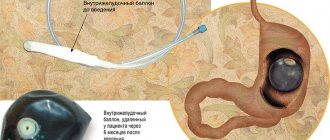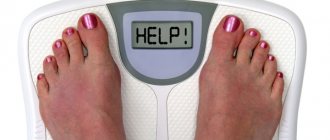What is important for a man to know?
In order for a man to produce sex hormones, and therefore to realize sexual function and the ability to bear children, his body must receive a sufficient amount of fat, since it is from fat that the main male hormone, testosterone, is synthesized.
However, with excess intake of fat into the body and/or disruption of fat metabolism, adipose tissue accumulates, which, on the contrary, disrupts the production of male sex hormones, leading to sexual dysfunction and, in some cases, infertility. Look at your reflection in the mirror. Have you exceeded the permissible reserves of adipose tissue? As the great philosopher and physician Avicenna said, “in the treatment of every disease, the fight against excess weight should be considered the first step.”
How to determine if a man is obese
Today, the main criterion for diagnosing obesity is waist circumference. Every man who wants to maintain health, including men's health, the key to which is a normal level of testosterone, should know that if his waist circumference is more than 94 cm, he has a terrible diagnosis of obesity, and if his waist circumference is more than 102 cm, then, in addition to obesity, he most likely has a testosterone deficiency.
Indeed, the main feature of obesity in men is that obesity always leads to a lack of testosterone . Testosterone is the most important male sex hormone, determining not only a man’s sexual and social ambitions, but also playing a leading role in the clinical picture of obesity in men. Testosterone deficiency supports the deposition of excess fat tissue and reduces the effectiveness of treatment. In addition, testosterone is responsible for overall well-being, good mood, as well as muscle mass and strength.
The fact that all obese men have reduced testosterone levels has been proven in large scientific studies. So, in Norway, in the city of Tromsø, scientists examined 1,548 men. The examination was simple - men simply had their waist circumference measured and their testosterone levels determined. The results were stunning - it turned out that all men whose waist circumference exceeded 102 cm had reduced testosterone levels (Figure 1)!
Does the coordinated functioning of the reproductive system depend on weight?
Of course, a man’s weight depends on his height, type of activity (mainly mental or physical labor), eating habits, muscle tissue development, and general (somatic) health. At the same time, it almost does not depend on nationality or territory of residence. Throughout his life, a man’s weight should be optimal, that is, within the body mass index (BMI) range of 18.5 to 24.9 kg m2.
BMI is calculated using the following formula:
BMI = weight (kg) : height2 (m)
So, for example, if your weight is 120 kg and your height is 172 cm (1.72 m),
Therefore, your BMI = 120: (1.72 x 1.72) = = 40.6 kg/m2.
Now you! Check if you are a normal weight by calculating your BMI.
Men and women differ in the distribution and deposition of adipose tissue in the body. In women, most of the adipose tissue is deposited in peripheral fat depots such as the breasts, thighs and buttocks. In men, unlike women, the deposition of adipose tissue is central; the greatest accumulation occurs in the abdominal area, which is the highest risk factor for the development of various diseases. Therefore, in men, even with a normal BMI, measuring the waist circumference (WC), which is carried out at the level of the navel, helps determine the presence of obesity. If WC exceeds 94 cm, we can talk about obesity.
If your BMI or WC is above the healthy range, it may soon lead to problems with your reproductive system. The presence of obesity leads to impaired sexual function in men, and is accompanied by a high incidence of decreased libido, erectile dysfunction (impotence), infertility, and impaired sexual development in boys. The prevalence of sexual dysfunction in obese men is quite high - more than 50%.
The described changes occur due to disruption of the production and metabolism of one of the main male sex hormones - testosterone. The more adipose tissue, the lower the amount of testosterone and its activity. It is in adipose tissue that testosterone is converted into female sex hormones - estrogens, which is why a gradual feminization of a man occurs with a parallel decrease in sexual function. In addition to disrupting the synthesis and production of testosterone, adipose tissue produces many factors that have a negative impact on the central mechanisms regulating the functions of the male genital organs. In addition, in most overweight men, carbohydrate and fat metabolism is disrupted, and hypertension, coronary artery disease and diabetes mellitus develop. These conditions also suppress sexual function.
Types of obesity
By origin, obesity can be:
- nutritional-constitutional, associated with heredity, physical inactivity and addiction to food;
- secondary, associated with other diseases, taking medications.
According to the nature of the distribution of fat deposits, it can be:
- according to the male type - fat is located in the upper part of the body (internal obesity and proliferation of subcutaneous tissue);
- female-type obesity in men - fat deposits appear on the lower part of the body (hips, buttocks), the mammary glands noticeably enlarge;
- The mixed type is characterized by the same distribution of fat throughout the body; there may be signs of obesity, both female and male.
How can a person determine that he is overweight?
The obesity (body weight) index is a special indicator that is used to monitor weight changes. Anyone can calculate their obesity index (BMI). To do this, you need to divide your body weight in kilograms by your height (m) squared. The normal index ranges from 18.5 to 24.9. If the BMI is below 18.5, they are said to be underweight.
BMI can be used to determine the degree of obesity in women and men. For this purpose, an obesity table has been developed, based on which:
- 1st degree obesity in men (women) with a BMI of 25.0 – 29.9;
- obesity 2 degrees in men (women) with a BMI of 30.0 – 34.9;
- obesity 3 degrees in women (men) with a BMI of 35.0 – 39.9;
- obesity 4 degrees with a BMI of 40.0 and above.
There is also the so-called ideal body weight index.
For men, the indicator is calculated as follows: 50kg + (height (cm) - 150) * 0.75.
Knowing a person’s ideal weight, you can calculate how many extra pounds have accumulated and determine the stages of obesity in men.
- First stage - weight exceeds ideal weight by 29%;
- Second stage - by 30% - 49%;
With stage three obesity, the weight exceeds the ideal weight by 50% or more.
You can also determine excess weight using a regular measuring tape. If you don’t want to go into mathematical calculations, measure your waist circumference: normally, for men, the circumference should not exceed 94 centimeters. First degree obesity in men is with a waist circumference from 95 to 101 cm. But if the circumference is higher, what to do?
You need to consult your doctor. The specialist knows what tests and additional studies to prescribe for you. According to indications, ultrasound diagnostics, computed tomography, and MRI are used. Some people are prescribed tests for disruption of the endocrine glands - they examine the level of hormones in the blood. It is also necessary to take blood tests for glucose, cholesterol and other substances.
The role of genetics in weight gain
Often, if a man suffers from a problem such as excess body weight, he begins to rely on genetics. Indeed, it has been proven that in almost 100% of obese men, someone in the family is also overweight or obese (mom, dad, brother, sister, children).
There are several gene mutations (changes) that can cause obesity. These mutations most often also contribute to the development of type 2 diabetes mellitus and other endocrine diseases. At the same time, scientists have proven that most often lifestyle influences the implementation of gene mutation. That is, even in the presence of a genetically determined factor of obesity, it is quite possible to maintain a normal weight throughout life. An example of this is an experiment in which, after the birth of a pair of identical twins from an obese mother, the children were separated. The first child was left with his biological mother and father (both obese), and the second child was placed in foster care, where healthy eating and physical activity were priorities. After 20 years, the first young man was overweight, the second was healthy and athletic. This experiment clearly shows: not everything depends on genetics.
Consequences of excess weight in men
- Cardiovascular disorders
Long-term disruptions in the functioning of the heart and blood vessels can lead to increased blood pressure - the so-called. arterial hypertension. The inability of the heart to consistently pump blood through the circulation leads to heart failure. If there is a disturbance in the blood supply to the brain in acute cases, a stroke cannot be ruled out. And with myocardial infarction, the heart muscle partially dies, thrombosis and varicose veins of the extremities are also possible, which leads to damage to the veins.
- Musculoskeletal
Obesity can lead to osteochondrosis and scoliosis of the spine, as well as provoke inflammatory processes and joint pain - that is, arthritis.
- Exchange
Non-insulin-dependent diabetes (or type 2 diabetes) is also associated with obesity, which impairs the metabolism of carbohydrates in the body. Impaired fat metabolism leads to atherosclerosis and hyperlipidemia. The deposition of salts in the kidneys and joints leads to gout.
- Respiratory
Night snoring is another consequence of excess weight. When combined with shortness of breath and slow or stopping breathing at night (apnea), it can also be dangerous.
- Gastrointestinal
Stones formed in the gall bladder lead to cholelithiasis.
- Oncological
Obese people are more likely to develop colorectal and prostate cancer.
The consequences of the main problems of excess weight listed above speak for themselves, but obese men are also at risk of developing sexual dysfunction - this includes decreased libido (sexual desire) and erectile dysfunction.
As body mass index increases, the quality and quantity of male sperm decrease significantly. The characteristics of seminal fluid deteriorate, which can lead to partial or even complete infertility, the so-called “sterility”. The sperm of obese men are less viable and may have significant defects, which in turn leads to the inability to fertilize the egg and the risk of developing genetic mutations. The more pronounced the obesity, the greater the likelihood of genetic defects.
In teenagers, being overweight is also very dangerous. The increase in extra pounds leads to a deficiency in the production of male hormones that trigger the mechanisms of puberty. In boys, this can cause delayed puberty.
How can you change your eating habits?
In Russia, 10-20% of men are obese, but the real prevalence of obesity among men is higher, which is due to low rates of treatment. Moreover, the formation of eating behavior begins from the moment of intrauterine development of the child and during the first year of life. The diet of the expectant mother already shapes the future habits of the child.
To date, given the abundance of food, the growing well-being of the population, the habit of eating more than necessary and storing energy reserves under one’s own covers is irrelevant. In addition, the modern trend towards accelerating the pace of life and the desire to obtain the maximum amount of material wealth has contributed to the enormous development of fast food establishments. Consequently, there are more and more overweight people on the planet. If action is not taken today, millions of people will become victims of cardiovascular, musculoskeletal and other diseases tomorrow. Therefore, the rhythm of nutrition, the family’s diet and its food preferences should be based on the following 12 principles:
Eat a variety of foods, most of which are plant-based rather than animal-based. Bread, flour products, cereals, potatoes should be consumed several times a day.
Eat a variety of vegetables and fruits several times a day, preferably fresh and grown locally (at least 400 g per day).
To maintain body weight within the recommended range (body mass index 20-25), daily moderate physical activity is necessary.
Control the intake of fat from food (no more than 30% of daily calories) and replace animal fat with vegetable fat.
Replace fatty meats and meat products with legumes, grains, fish, poultry or lean meats.
Consume low-fat milk and dairy products (kefir, sour milk, yogurt and cheese) that are low in fat and salt.
Choose low-sugar foods and consume sugar in moderation by limiting sweets and sugary drinks.
Eat less salt. The total amount of salt in food should not exceed one teaspoon - 5 g per day. You should use iodized salt.
If you drink alcoholic beverages, the total content of pure alcohol in them should not exceed 20 g per day.
Food preparation must ensure its safety. Steaming, microwaving, baking or boiling foods will help reduce the amount of fat, oil, salt and sugar used in the cooking process.
How does metabolic syndrome develop?
Of course, not every person is susceptible to insulin resistance, even if they have risk factors in their body. There is a certain pathogenesis (mechanism of development) of metabolic syndrome. Here are the conditions under which this happens:
- If risk factors exist (for example, a predisposition to obesity and type 2 diabetes mellitus in the family), but the man does not avoid them, but, on the contrary, leads a sedentary lifestyle, eats poorly, all of which ultimately leads to impaired receptor sensitivity, that come into contact with insulin.
- Because of this, the pancreas has to overcome insulin resistance and produce more insulin to provide the cells with glucose.
- As a result, excess insulin appears in the blood, which leads to obesity, increased blood pressure, and problems in the cardiovascular system.
- “Excess” glucose, which could not be absorbed, remains in the blood: a state of hyperglycemia develops, which destroys proteins and causes premature aging of cells.
Can your andrologist help not only in the fight for men's health, but also in the process of weight loss?
For professional weight loss, men are mostly accustomed to turning to an endocrinologist, psychotherapist or cosmetic surgeon. But remember: weight optimization is a long-term process, and you need to maintain the results achieved throughout your life. You cannot prescribe a short course of treatment and achieve what you want. Therefore, it is the andrologist who is obliged to help a man throughout his life. Who, if not a specialist in men's health, knows all the secrets of the different periods of a man's life and their connection with metabolic processes in the body, especially since the relationship between dysfunction of the gonads and the development of obesity has been known for a long time.
It is known that eunuchs, as a rule, are obese, and their obesity develops immediately after castration. But obesity also occurs in men initially with a normal reproductive system, and as obesity progresses, testosterone levels in the body decrease.
Thus, testosterone deficiency in obese men is an important factor in both the development and progression of obesity, since testosterone deficiency significantly reduces physical activity, the role of which in weight loss is very large.
You can suspect testosterone deficiency by answering 10 questions:
- Do you notice a decrease in sexual desire (decreased pleasure from sex, lack of desire for sexual contact)?
- Have you become less energetic?
- Have you noticed a decrease in physical strength and/or endurance?
- Has your height decreased?
- Do you notice a decrease in “pleasure in life” (the feeling that the peak of life has been passed)?
- Have you become sad and/or irritable?
- Are you experiencing a decrease in the quality of your erections?
- Have you noticed a recent decline in your ability to participate in sports?
- Do you fall asleep after lunch?
- Has your performance decreased?
If you answer “yes” to question 1.7 or any three other questions, it is highly likely that you have testosterone deficiency and a medical examination by an andrologist is necessary. Since testosterone deficiency in obese men is a significant factor maintaining obesity, therapy aimed at normalizing testosterone levels in the blood plasma should play an important role in the complex treatment of obesity. An important issue is the choice of drug and dose selection, which must be decided individually for each patient.
Male obesity and its therapy
Excess weight is more dangerous in men than in women
The most common chronic disease is obesity.
According to WHO, about 1.7 billion people on our planet are overweight, and in Russia - 30-40% of women and 10-20% of men. But the actual prevalence of this disease among men is higher, which is due to low negotiability. An important feature of male obesity is not only the severity of the disease, leading to a decrease in life expectancy due to the development of dangerous concomitant diseases, but also disturbances in the metabolism of sex hormones, which contribute to the progression of obesity. Obesity is a heterogeneous pathology, that is, its causes are different. The development of the disease may be due to dysfunction of the mechanisms regulating the energy balance: psychoneurological, hormonal and metabolic. Thus, endocrine and metabolic disorders in obese men are based on disturbances in the secretion, inactivation and binding of sex hormones, including testosterone, to plasma proteins.
Testosterone is the most important male sex hormone with pronounced anabolic and lipolytic activity. Its basal plasma level decreases in the presence of obesity. There was a positive relationship between testosterone levels and the ratio of waist circumference to hip circumference in men. It has also been established that reduced androgenic plasma activity in men has a great influence on the increase in visceral adipocytes. An inverse relationship is revealed between insulin resistance (IR) and testosterone levels, since it affects IR through a fat-mobilizing effect - the release of free fatty acids from the fat depot.
What comes first - obesity or hypogonadism?
The decrease in testosterone concentration in obesity is aggravated by age-related changes in the hormone. In men, the level of sex hormones, primarily testosterone, decreases with age. This process begins at the age of 30-40 years, then testosterone levels drop by about 1-2% per year. The main amount (more than 98%) of testosterone circulates in the plasma in a bound state: up to 58-60% of the hormone is with albumin, about 40% is with sex steroid binding globulin (GSBG). And only 1-2% is in free form.
The “bioavailable” fraction of testosterone is the freely circulating fraction and the portion of the hormone that is weakly bound to albumin. But the part of testosterone associated with GSPC does not exhibit biological activity. An age-related decrease in the content of total testosterone occurs simultaneously with an age-related increase in the concentration of SHB. This leads to a slight decrease in the content of total testosterone in the blood serum, while as a result of a decrease in the secretion of testosterone in the testicles, the content of biologically active and free testosterone decreases. Due to this, androgen deficiency increases.
But is the disturbance in testosterone secretion primary or secondary to obesity? Some authors consider hormonal disorders to be secondary, because reducing body weight leads to normalization of testosterone levels. It is believed that one of the reasons for the formation and maintenance of hypogonadism in obese patients is the aromatase activity of excess adipose tissue. This enzyme converts androgens (testosterone) into estrogens (estradiol), which suppress the secretion of both gonadotropin releasing hormone and luteinizing hormone (LH). Ultimately, this is manifested by a decrease in testosterone levels in the blood, in other words, secondary hypogonadism.
However, according to other authors, it is hormonal changes that are primary, which is confirmed by exogenous administration of testosterone. In men, this significantly reduces the amount of visceral fat, reduces IR, decreases diastolic blood pressure and improves the lipid profile. Studies conducted in obese men over 45 years of age have shown improvements in insulin sensitivity, fasting blood glucose, and diastolic blood pressure during androgen therapy.
Endocrinological tests can detect the presence of hypogonadism in obese men. During clinical examination, it is useful to use specialized questionnaires, for example AMS according to Heinemann. The concentration of total testosterone less than 12 nmol/l with normal, decreased or increased levels of gonadotropins in combination with clinical symptoms allows us to diagnose normogonadotropic, hypogonadotropic or hypergonadotropic hypogonadism, respectively. In cases where the clinical symptoms of hypogonadism are clear and the level of total testosterone is within normal limits, it is necessary to determine SHBG with further calculation of the level of free testosterone. When it decreases, hypogonadism is diagnosed.
Treatment of obesity must be comprehensive
Diagnosis of hypogonadism in obese men is extremely important, since this factor is one of the leading factors for the maintenance and progression of obesity. Since testosterone is the main anabolic hormone, its deficiency significantly reduces physical activity, the role of which in weight loss is very large. According to the US National Institutes of Health, 30-60% of patients who begin active physical exercise return to their previous weight within a year and almost all within 5 years. Thus, the need for complex therapy for obese patients, including pharmacological drugs to normalize testosterone levels (androgen therapy - AT), becomes obvious.
The distribution of fat in the body is uneven. Its predominant deposition in the thighs and buttocks is more typical for women. Therefore, it is called “gynoid”, or lower type obesity. But excess accumulation of fat in the torso and especially the abdomen (or abdominal obesity) is more typical for men. That’s why it is often called “android”. With the same body mass index, it is abdominal obesity that is accompanied by a higher risk of developing concomitant diseases. Therefore, the severity of obesity complications is higher in men than in women.
The main goals of therapy for hypogonadism in men are: complete elimination of androgen deficiency - restoration of libido and potency, increasing muscle strength, treatment or prevention of osteoporosis, as well as restoration of fertility. Against the background of AT in patients with hypogonadism, sexual function is normalized and visceral obesity is reduced. The positive effects of AT also include an anabolic effect on muscles. In men with hypogonadism, against the background of AT, mood and general well-being improve. A decrease in cholesterol levels under the influence of androgens is another positive effect of AT.
Among its side effects, it should be noted the formation of acne due to stimulation of the sebaceous glands of the skin, the occurrence of gynecomastia, the latter effect depending on the ability of androgens to aromatize into estrogens. Androgen overdose can also cause sodium and water retention, leading to edema.
Monitoring is required during androgen therapy
Patients receiving androgen therapy should undergo periodic clinical examination and laboratory tests. In younger men they can be performed at annual intervals, but in older men they can be performed every 3-6 months. The restoration of sexual functions can be monitored by the patient completing sexological questionnaires. Testosterone concentrations should be monitored. Because androgens stimulate the production of erythropoietin by the kidneys and also act on bone marrow stem cells, an increase in hemoglobin and hematocrit levels is observed after androgen administration, which also needs to be monitored. At the beginning of therapy and thereafter at semi-annual intervals, monitoring of the serum lipid profile (cholesterol, HDL and LDL) and liver function is required. In men over 40 years of age, it is advisable to conduct a digital rectal examination once every 6-12 months and determine the content of prostate-specific antigen in the blood serum to identify possible prostate diseases.
In addition to eliminating androgen deficiency, an important goal in the treatment of hypogonadism is to restore fertility. In patients with hypergonadotropic hypogonadism, the prognosis for restoration of fertility is almost hopeless. In most men with hypogonadotropic hypogonadism without damage to the spermatogenic epithelium of the testicles, treatment with gonadotropin drugs leads to improved spermatogenesis and restoration of fertility.
Thus, obesity in men is characterized by a high prevalence of hypogonadism, which is one of the main factors in the development and progression of excess weight accumulation. This dictates the need for active detection of hypogonadism. In order to detect it, it is necessary to assess the psychological, sexual and somatic status of the patient, including laboratory determination of the levels of total testosterone, gonadotropins and SHBG with further calculation of the level of free testosterone. In such men, AT should be prescribed. This will certainly help improve quality of life and prevent later and dangerous complications of obesity. Optimal therapy is also a balanced diet and physical activity in combination with medications that promote weight loss and eliminate testosterone deficiency.










